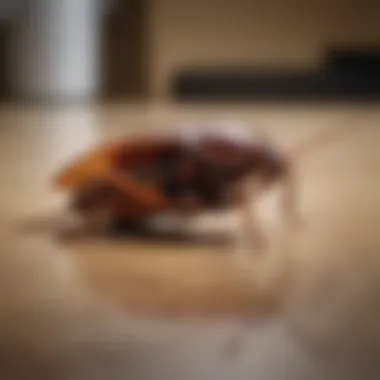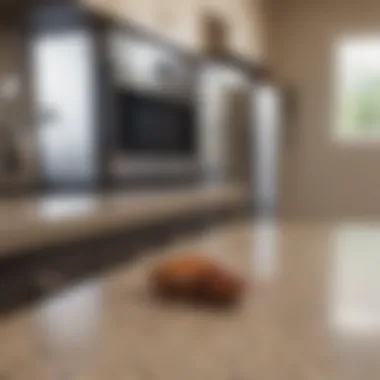Effective Strategies for Managing Kitchen Roach Infestations


Intro
Cockroach infestations in kitchens pose a significant inconvenience for homeowners. These pests are not only disturbing but also carry health risks. Understanding the behavior of cockroaches is essential in both prevention and extermination. It helps in recognizing their patterns and identifying their entry points. This knowledge base lays the groundwork for effective strategies to eliminate roaches and maintain a clean kitchen environment.
The kitchen, being a hub of food preparation, is an attractive space for these insects. They thrive in warm, moist environments and are often found near food sources. To combat this, a comprehensive approach focusing on sanitation practices, prevention methods, and both chemical and natural extermination techniques will be outlined.
By grasping these concepts, you will be empowered to implement practical measures that not only get rid of current infestations but also prevent future occurrences. This article serves as a guide to manage and eliminate roach problems, facilitating a healthier living space.
Understanding Cockroach Behavior
Understanding cockroach behavior is crucial for effectively managing infestations in kitchens. Knowledge about how these pests operate, including their habits and preferences, provides insights that can help homeowners take proactive measures. Roaches are nocturnal creatures, which means they become active mostly at night. This behavior affects how and when you should look for them or set traps. Moreover, recognizing their behavior patterns can assist in tailoring sanitation practices and treatments to disrupt their lifestyle, making your approach more effective.
Common Species Found in Kitchens
Several species of cockroaches are commonly found in kitchen environments. The American cockroach, known for its large size, often prefers warm areas and can thrive in kitchens. German cockroaches are smaller and are more prevalent in homes. They can reproduce quickly and are often found in food preparation areas. Another species is the Oriental cockroach which is less common but also invades kitchens, especially during colder months. Understanding these species helps in identifying potential threats and adopting targeted control methods.
Lifecycle and Reproduction
Cockroaches have a relatively simple life cycle consisting of three stages: egg, nymph, and adult. The female German cockroach produces around 40 eggs at a time, encased in an ootheca, which she carries until they are nearly ready to hatch. This rapid reproduction rate means that even a small infestation can grow quickly. American cockroaches can live up to two years, contributing to their persistence in a home. Being aware of their lifecycle can aid in recognizing when you might need to implement intensive control measures, especially during peak breeding seasons.
Feeding Habits and Preferences
Cockroaches are opportunistic feeders, meaning they consume a variety of food items, including crumbs, grease, and any organic material they can find. They are particularly drawn to carbohydrates and fats. This is vital to consider when planning prevention strategies. If your kitchen has excess food debris or improperly stored items, it becomes an inviting environment for cockroaches. Keeping food sealed and disposing of waste properly deter them effectively. Recognizing feeding habits allows the formulation of more disciplined sanitation routines.
"Understanding the behavior, lifecycle, and feeding patterns of cockroaches is a stepping stone in controlling their population in kitchen settings."
By grasping these aspects of cockroach behavior, homeowners can create more efficient pest management strategies. It leads to a systematic approach to cleanliness, food storage, and identifying potential entry points for these nuisances.
Identifying Signs of Infestation
Understanding the signs of a cockroach infestation is vital to managing and eliminating these pests effectively. Early identification of these signs allows homeowners to take timely action. This can help prevent a small issue from escalating into a full-blown infestation, which can be more difficult and expensive to control.
When one becomes aware of the specific signs, they can take appropriate measures. For instance, decreasing food availability can significantly reduce the attraction for roaches. Additionally, knowing where to look and what to watch for enhances one's ability to respond and apply preventative strategies.
Physical Evidence of Roaches
Physical evidence is one of the most direct indicators of a roach problem. Observing roach droppings can be an alarming first sign. These droppings appear similar to coffee grounds or small black pellets and are often found in areas where roaches are active. Common locations include underneath sinks, along baseboards, and in cabinets. Pay attention to these areas during your daily cleaning routine.
Another form of evidence includes shed skins. Roaches shed their exoskeletons regularly, especially during the nymph stage. Finding these skins can indicate not just the presence of roaches but also their breeding activity.
Additionally, you may notice stains or smear marks on surfaces. This can occur when a roach moves over an area, leaving behind oils from their bodies that can result in discolored patches.
Odors Associated with Infestations
Unpleasant odors can give away an infestation even before one visually encounters a cockroach. The scent has been compared to decaying material, which makes sense as roaches often thrive in filth. One might initially notice these odors in cabinets, kitchens, or trash areas. As the infestation grows, the scent becomes more potent, indicating a serious problem.
If there is a musty smell in the kitchen but no obvious signs of infestation, this could indicate hidden roaches. Identifying such odors early can prompt a more thorough inspection of commonly overlooked places.
Common Hiding Places in the Kitchen
Cockroaches prefer dark, moist, and undisturbed areas for their hiding spots. In the kitchen, this generally includes places that are not frequently cleaned or inspected.


- Behind Appliances: The space behind refrigerators, stoves, and dishwashers provides an ideal atmosphere for roaches.
- Under Sinks: Kitchens often have moisture accumulation in these areas, making it a perfect refuge for roaches.
- In Cabinets: Food remnants and crumbs often reside in cabinets, attracting cockroaches. Closets, especially those where food is stored, can harbor nests.
- Within Wall Cracks: Roaches can enter through minute gaps in walls or flooring. Inspect these spaces during your inspection routine.
By understanding and identifying these signs of infestation, a homeowner can gain control over a potentially troubling situation. This knowledge empowers proactive measures, ensuring a cleaner and more hygienic kitchen environment.
1. Prevention Strategies
Preventing roach infestations is the first line of defense for any homeowner. This proactive approach can save time, money, and significant stress. The key elements in prevention include maintaining cleanliness, employing proper food storage techniques, and proactively sealing entry points.
Maintaining Cleanliness
Maintaining a clean kitchen is vital in preventing roach infestations. Roaches are drawn to food residue, grease, and crumbs. Regular cleaning routines can minimize these attractants. Wipe down counter tops daily and ensure that spills or crumbs are promptly addressed. Importantly, it is also beneficial to focus on areas rarely seen, like under appliances. Using environmentally-friendly cleaners can be effective.
Additionally, keeping the sink area clean is essential. Letting dirty dishes stack can create a perfect condition for roaches. It's advisable to wash and put away dishes promptly.
"A clean kitchen is a fortress against roaches."
Proper Food Storage Techniques
Food should be stored properly to deter roaches. Use airtight containers to store dry food items like grains, cereals, and snacks. These containers help to eliminate food accessibility for roaches. Similarly, be mindful of perishables. Fruits and vegetables can attract bugs if left out for long. Consider refrigeration for items that do not need to be on the counter.
Other key practices include regularly checking pantry items. Expired food can become a breeding ground for pests. Rotating stock and maintaining an organized pantry aids in effective monitoring.
Sealing Entry Points
Sealing entry points is another crucial strategy. Roaches can slip through surprisingly small gaps. Inspect areas around windows, doors, and baseboards. Using caulk or weather stripping can effectively seal cracks and provide an added barrier.
Also, check plumbing fixtures. Gaps around pipes can also become entry points. Ensure that these areas are sealed well to prevent an intrusion. Regular inspection of your home can help catch issues before they escalate into infestations.
By adopting these prevention strategies, homeowners can significantly reduce the likelihood of a roach infestation. Ultimately, a clean home, secure food storage, and sealed entry points work together to create an environment where roaches cannot thrive.
2. Sanitation Practices
Sanitation practices are crucial in the fight against cockroach infestations in kitchens. A clean environment significantly reduces the chances of roaches finding food and shelter. Regular sanitation helps eliminate potential breeding sites and feeding locations, making it less appealing for roaches to invade. Understanding and implementing effective sanitation measures not only creates a healthier living space but also serves as a proactive approach to pest management.
Daily Cleaning Routines
Establishing thorough daily cleaning routines is essential. Start by wiping down kitchen surfaces after each meal. This includes countertops, tables, and other areas where food might be prepared or consumed.
- Sweep and mop: Regular sweeping and mopping can remove crumbs and spills that attract roaches.
- Dishes: Always wash dishes promptly to avoid any buildup.
- Appliances: Don't neglect areas behind and underneath appliances, as these can harbor food particles and dirt.
Such habits prevent food sources from being readily available, discouraging roaches from entering your kitchen.
Decluttering Strategies
Decluttering is another vital aspect of sanitation practices. A cluttered kitchen provides excellent hiding spots for cockroaches. Reducing clutter has several advantages:
- Organized Spaces: An organized kitchen prevents items from piling up. Storing food and utensils properly inhibits roaches from finding places to hide.
- Regular Inspection: Decluttering allows for more frequent and detailed inspections, making it easier to spot signs of infestation early.
Consider using air-tight containers for food storage. This not only keeps food fresh but also minimizes the risk of access for roaches.
Effective Waste Management


Effective waste management plays a significant role in reducing the likelihood of cockroach infestations. Trash bins in kitchens should be managed with care:
- Seal Bins: Always use bins with tight-fitting lids to prevent access.
- Regular Disposal: Dispose of garbage regularly to avoid accumulation.
- Compost: If composting, ensure that it is managed properly. Organic waste can attract roaches if left unchecked.
Maintaining a clean and well-organized kitchen not only boosts your cooking experience but also serves as a vital barrier against cockroach infestations.
Regular sanitation practices lead to a noticeable decrease in pest presence, enhancing your home environment.
Implementing these strategies creates an unwelcoming atmosphere for cockroaches, laying the groundwork for effective pest management.
3. Chemical Control Options
Chemical control options play a crucial role in managing cockroach infestations, especially in the kitchen. While prevention and sanitation are key first steps, sometimes the problem escalates, and chemical methods become necessary. These options must be selected and applied with consideration for both efficacy and safety. Understanding the different types of chemical controls available, their applications, and whether to hire professionals can help homeowners tackle roach problems more effectively.
Insecticides: Types and Applications
Insecticides are designed to kill pests, making them a common choice for controlling cockroach populations. There are several types of insecticides, each with unique benefits and modes of action.
- Contact Insecticides: These kill roaches immediately upon contact. They are effective for quick solutions but may need reapplication as they do not leave residues for long-lasting protection.
- Residual Insecticides: These remain active for a longer period, continuing to kill roaches that come into contact with treated surfaces. They provide prolonged efficacy but require careful application to minimize human exposure.
- Bait Insecticides: These use food attractants to entice roaches into consuming the poison. Roaches are social creatures; thus, they often carry the poison back to their nests, helping to eliminate more pests over time.
When using any insecticide, siwtching between types can prevent resistance build-up in roach populations. Homeowners should carefully read labels and follow the recommended dosages to prevent harm.
Baits and Traps: Effectiveness and Use
Baits and traps are another category of chemical control that targets roaches effectively. Baits usually come in ready-to-use stations or gels.
- Effectiveness: Bait stations attract roaches, which then consume the poison. This can reduce numbers significantly, as affected roaches die and transfer poison to others. The use of baits can be particularly effective in spaces where insecticide spraying might be impractical.
- Usage Tips: Place bait stations in areas where roaches are known to be active, such as along walls, under sinks, and near food storage areas. Ensure they are out of reach from children and pets.
Traps, on the other hand, can be utilized to monitor roach activity while also catching them. Sticky traps can be discreetly positioned in potential roach hotspots.
Professional Pest Control Services
Sometimes, home remedies and over-the-counter products may not be enough to deal with a severe infestation. In these cases, seeking professional pest control services can be a sound decision.
- Benefits of Professional Services: Pest control experts have access to stronger chemical formulations and more sophisticated strategies to address infestations. They can also assess the situation more accurately and identify the source of the problem.
- Engaging Experts: When selecting a service, consider their experience with cockroach control, customer reviews, and safety protocols they employ. Experts can devise a long-term plan that not only addresses the immediate issue but provides ongoing monitoring and preventive measures.
4. Natural Remedies
Natural remedies offer a compelling alternative to traditional chemical solutions when addressing cockroach infestations in the kitchen. Many homeowners prefer these methods for various reasons. First, they often pose less risk to human health and the environment. Moreover, natural remedies can be more cost-effective and readily available. This section discusses three significant natural remedies: essential oils, diatomaceous earth, and homemade traps. Each offers unique benefits and considerations that make them worth exploring in your fight against roaches.
Essential Oils and Their Uses
Essential oils are concentrated plant extracts that have various uses in natural pest control. Oils such as peppermint, lavender, and tea tree have strong scents that can repel cockroaches. These oils disrupt roaches' sense of smell, which is critical for their survival and navigation.
- Repelling Effect: Essential oils can deter roaches without the use of harmful chemicals.
- Application Methods: A few drops of essential oils can be mixed with water in a spray bottle, then sprayed in areas where roaches are likely to appear, such as corners or under sinks.
- Considerations: It is important to ensure that essential oils are used in safe concentrations. While they are generally safe for humans and pets, some may cause allergic reactions. Always test a small area before widespread application.
Diatomaceous Earth as a Solution
Diatomaceous earth is a naturally occurring substance made from the fossilized remains of tiny, aquatic organisms called diatoms. This powdery substance is effective against cockroaches because it acts as a desiccant, damaging the protective exoskeleton of insects and causing dehydration.
- Non-Toxic Nature: Diatomaceous earth is safe for humans and pets when food grade is used, making it an attractive option.
- Application: Sprinkle a thin layer in areas where cockroaches are seen or suspected. Roaches will unknowingly walk over it and be affected by its properties.
- Reapplication: It is necessary to reapply after cleaning or in damp areas, as moisture can reduce its effectiveness.


Homemade Traps and Repellents
Creating homemade traps is a simple and effective method for dealing with roaches. These traps utilize common household ingredients and materials to capture roaches. One popular option is a mixture of sugar and baking soda. The sugar attracts the cockroaches, and the baking soda, when ingested, kills them.
- Simple Recipe for a Trap:
- Alternative Solutions: Other traps can be made using soapy water in a container. Place it near cockroach pathways; they fall into the water and cannot escape.
- Repellents: Adding vinegar to the water helps deter roaches from returning to the area.
- Mix equal parts of sugar and baking soda.
- Place the mixture in shallow dishes around infested areas.
Natural remedies are often less harmful and provide a viable solution for managing cockroach infestations.
Assessing the Impact of Infestation
Understanding the impact of cockroach infestations is crucial for any homeowner. The presence of these pests affects not only the cleanliness of the kitchen but also the general health of the inhabitants. This section outlines key elements and considerations related to an infestation, emphasizing the significant implications that come with ignoring a roach problem.
Health Concerns Related to Roaches
Cockroaches are known carriers of various pathogens. They can contaminate food and surfaces with bacteria such as Salmonella and E. coli. Exposure to cockroach droppings, saliva, and shed body parts can trigger allergic reactions in sensitive individuals. Common symptoms include asthma, skin rashes, and respiratory issues. For children and the elderly, who often have weakened immune systems, the health risks increase significantly. It's important to take these concerns seriously and understand that a cockroach infestation is not just an inconvenience; it poses real health risks.
Damage to Property and Food Sources
In addition to health risks, cockroaches can cause damage to property and food sources. They often chew through packaging, leading to food contamination. They can also damage wallpaper, insulation, and other materials within the kitchen. The structural integrity of your home may also be compromised if the infestation goes unchecked. This leads to potentially expensive repairs. Early detection and proactive management of roaches are essential to mitigate these risks.
"Ignoring a cockroach problem often leads to increased health risks and property damage."
Long-term Management Strategies
Long-term management strategies are essential for maintaining a roach-free kitchen environment. These strategies ensure that once an infestation has been addressed, the risk of future infestations is minimized. They focus on preventing re-entry of pests, improving overall sanitation, and increasing awareness about the factors that attract roaches to a space. By implementing these strategies, homeowners can save on potential costs associated with repeated extermination efforts and create a more pleasant and hygienic cooking space.
Regular Monitoring and Maintenance
Regular monitoring and maintenance are crucial components of effective pest management. Checking for signs of roach activity on a consistent basis helps catch an infestation early, which is key for rapid control. This process involves frequently inspecting common hiding areas, such as behind appliances, under sinks, and in cabinets. Homeowners should also look for droppings, shed skins, or any damage to food packaging.
In addition to visual inspections, setting up traps can provide insight into roach activity. Sticky traps, for example, can help count and identify species present in the kitchen. By marking the location of traps, one can pinpoint hotspots of activity and focus management efforts there. A regular schedule, perhaps bi-weekly or monthly, helps keep the kitchen in check.
The maintenance aspect includes keeping kitchen areas clean and organized. Ensuring surfaces are wiped down, food is stored in sealed containers, and waste is disposed of properly contributes to reducing attractants.
Community Awareness and Best Practices
Community awareness is critical in pest management. When neighbors are informed about cockroach behavior and control methods, the chances of a coordinated effort against infestations increase significantly. Organizing community workshops or using social media platforms like Facebook or Reddit to share information creates a shared knowledge base. Discussions can facilitate the exchange of useful tips and experiences related to pest management.
Best practices for the community may include:
- Participating in local cleanup events to reduce breeding grounds by removing clutter in shared spaces.
- Establishing regular communication among neighbors regarding pest sightings can help identify larger infestations.
- Educating children and adults alike about sanitation techniques to sustain cleaner environments.
In essence, long-term strategies are not only about individual actions but also fostering a broader cultural awareness. Collectively refined practices lead to healthier kitchens and overall improved living conditions.
End
The conclusion holds significant weight in this article as it crystallizes the main points and strategies discussed throughout the sections. It allows readers to distill essential knowledge into actionable practices that can effectively manage and eliminate roach infestations in their kitchens. The topics covered thus far have interwoven practical prevention methods with effective extermination techniques, creating a cohesive framework for readers to follow.
Summarizing Key Prevention and Control Methods
To combat cockroach infestations, it is vital to adopt a multifaceted approach. The following methods stand out:
- Prevention: Maintaining a clean environment is crucial. Regularly clean spills and crumbs, and ensure no food is left out overnight.
- Food Storage: Storing food in airtight containers limits access for roaches. This simple change can make a significant difference.
- Sealing Entry Points: Identify and seal gaps around pipes, doors, and windows. Roaches are adept at squeezing through small openings, so this step can greatly reduce their access.
- Sanitation Practices: Implement daily cleaning routines, declutter surfaces, and manage waste effectively. These practices deter roaches by removing their food sources.
- Chemical and Natural Treatments: Both can be effective. Choose insecticides with caution and explore natural remedies like diatomaceous earth or essential oils for an eco-friendly solution.
- Regular Monitoring: Keep an eye on potential signs of infestation and check hiding places regularly.
- Community Awareness: Share knowledge about effective strategies within local communities to create a more informed approach to pest prevention.
Following these strategies not only helps in eradicating current infestations but also prevents future occurrences. The importance of a consistent, thorough approach cannot be overstated; it is the key to maintaining a roach-free kitchen.



